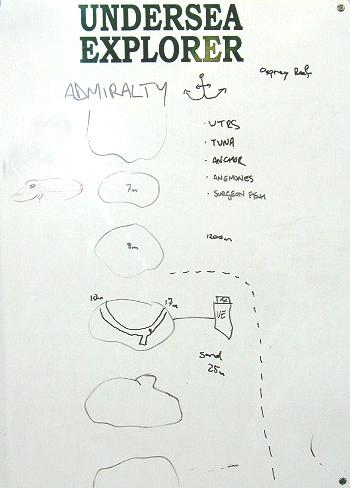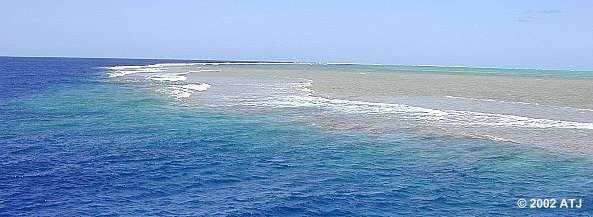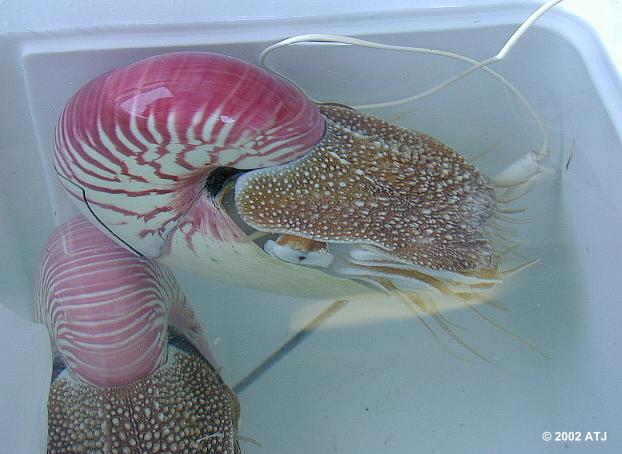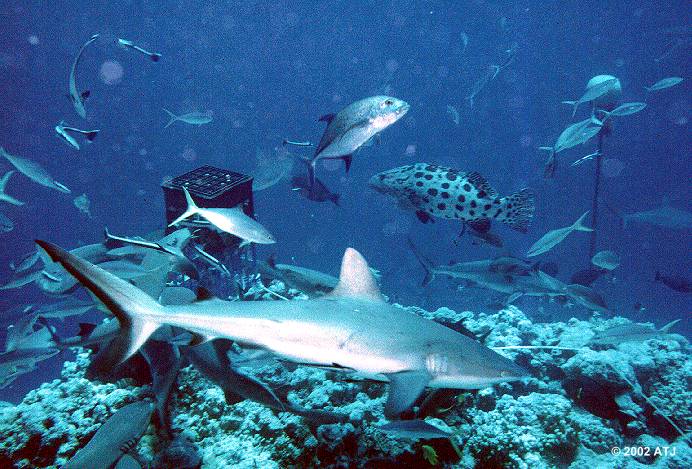 Divemaster Steve's representation of the dive site.
Divemaster Steve's representation of the dive site.
This is an account of my recent trip to The Great Barrier Reef and The Coral Sea aboard the Undersea Explorer. The Undersea Explorer mixes research and recreational diving for a truly fantastic experience. It is one of the few, if not the only, vessel that makes regular trips to Ospry Reef in The Coral Sea. For more information about the Undersea Explorer, please see their website at www.undersea.com.au.
Here is a map showing the dive sites.
After dinner in Port Douglas, we boarded the boat at around 7pm, got settled into our rooms and received a talk by John Rumney, the skipper (and manager of Undersea Explorer), on aspects of the boat and safety. This was followed by a quick introductory talk on the diving by the divemaster, Steve.
At around 8pm, we set sail for the area of Ribbon Reefs numbered 8-10, north east of Port Douglas. This was going to be an overnight trip and the seas were quite rough so most people headed for bed.
We arrived at Harrier Reef at around 8am. Harrier Reef is just inside the southern tip of Ribbon Reef #8. After a light breakfast and a dive briefing, we hit the water on our first dive. The reef was quite dead probably due to a crown-of-thorns plague some years ago and possibly a bleaching event earlier this year. However, there were still some interesting things to see and lots of fish. I found an in 19m of water as well as an close by in the same depth. Also seen were Xenia at around 5m and they were pulsating. (Dive details)
After a full breakfast we steamed north to Pixie Reef on Ribbon Reef #9. This reef was much more alive with a large number of Acropora spp. at all depths. At this dive site I assisted Anya with some transects for her research. Some interesting things seen, including a lot of and a silver in a cave. (Dive details)
After lunch we we headed to Challenger Bay on Ribbon Reef #10. Challenger Bay was a fairly shallow site with a bottom which was a mixture of sand and reef. All the usual fish suspects were there and there was also good cover of corals. Anya ran another transcect and we marked out the area so we could find it again for the night dive. (Dive details)
We stayed at Challenger Bay until after dark for a night dive. (Dive details)
Monday morning saw us at Pixie's Pinnacle, a small reef between Ribbon Reefs 9 and 10. The pinnacle is a bombie in around 30m of water with multiple shelves on one side. I saw most of the usual fish including a number of royal dottybacks () and one multi-barred angelfish (Paracentropyge multifasciatus). (Dive details)
After breakfast, we sailed to The Cod Hole at the northern end of Ribbon Reef 10. This dive site is so named because of the large potato cod (Epinephelus tukula) that frequent it. The site was generally sandy with a number of bommies and reefs in rows. The cod were very friendly. Highlights included watching a pair of orange-spotted filefish () drifting through colonies of Acropora. (Dive details)
The afternoon dive was at No Name which is slightly north of The Cod Hole. (Dive details)
The night dive was back at The Cod Hole. Mikhail and I helped Anya with some transects and also had fun with the cod which followed us around in the hope of catching sleeping fish in our flashlights. (Dive details)
After dinner we steamed for Osprey Reef, which is a 10 hour journey from the Ribbon Reefs.
We arrived at Osprey Reef at around 8am and were ready to dive almost immediately. The first dive spot for the day was Admiralty Anchor, which includes a series of tall bommies in around 35 m of water, however, the edge drops away quickly into around 1000 m of water. The top of each bommie was around 5 m deep.
 Divemaster Steve's representation of the dive site.
Divemaster Steve's representation of the dive site.
On the first dive I went to 42m and after feeling the onset of nitrogen narcosis, I didn't stay long at that depth. What was interesting at that depth, was the number of Acropora spp. colonies at that depth and deeper, some probably deeper than 50 m. This just goes to reinforce the notion that Acropora and other so called "SPS" corals are far more photoadaptive that most aquarists give credit.
Further up the wall, I saw colonies of Goniopora sp., probably . There were large schools of Hemitaurichthys polylepis, which had not been seen on the previous dives, and I also saw three . (Dive details)
North Horn (Dive details)

View down the eastern side for Osprey Reef from North Horn.
North Horn (Dive details)
Admiralty Anchor. (Dive details)
During the last dive Scott, Undersea's onboard marine biologist, set some traps to catch chambered nautilus . The traps were set off the edge of the reef at Admiralty Anchor at a depth of around 300m where the cephalopods patrol at night looking for food.
We were up early so that Anya, Mkihail and I could do two transcects at Admiralty Anchor. This was going to be a long dive so I stayed fairly shallow cruising around the top of the bommie. (Dive details)
While Anya, Mikhail and I were out on our early morning dive, Scott retrieved the nautilus traps, scoring 7 animals. During the course of the day these animals were measured, logged and tagged. For the rest of the day they were kept in coolers with ice to ensure the water temperature stayed low.

Two chambered nautilus Nautilus pompilius in the cooler on board the Undersea Explorer.
After a late breakfast we headed back into the water at North Horn for the "Shark Attract". Undersea Explorer do not feed the sharks but simply attract them using fish offcuts in a cage made from two milk crates tied together. The observers head into the water first and get positioned around behind the "pulpit", a raised area to which the food cage is tied. (Dive details)

One of the Grey reef whalers Carcharhinus amblyrhynchos at the "Shark Attract".
After lunch, we did another dive at North Horn. There were still a lot of sharks around when we entered the water as the cage with food was still on the pulpit. On this dive we headed south down the west wall of North Horn. This was a near vertical wall extending from the edge of reef flat at around 5m down to a ledge in 30-40m of water. Over the edge it dropped to around 1000m. Along the wall there were the usual suspects, Acropora and Pocillopora, but there was also a higher presences of soft corals, mainly gorgonians. It was on this dive I saw my one and only clown triggerfish Balistoides conspicillum and also my only pair of dusky butterflyfish . (Dive details)
Following the afternoon dive, we headed back to Admiralty Anchor to release the nautilus. While they wouldn't actually be released until well after dark, those that had underwater cameras were invited to take a nautilus into the water to photograph. Nautilus are quite slow moving and it was very easy to get some pretty good shots of these beautiful and unusual creatures. (Dive details)
We arrived at Rouge on Ribbon Reef #5 at around 9:30am and after a quick dive briefing we were in the water for a drop dive. The dive was on a patch reef with near vertical walls to 30m. The reef flat was in around 5-8m of water and was dominated by table Acropora. I saw many corals including an encrusting Goniopora. (Dive details)
At 12:30pm we arrived at Steve's Bommie on Ribbon Reef #3. Following the dive briefing we were in the water before 1pm. The bommie is in around 35m of water which drops away even further. On one side it is a sheer wall but on the other side it is stepped. The formation results in a great deal of diversity of coral species with some corals on the vertical walls and others in caves and overhangs. Most of the were in caves, but one colony was on the top of the bommie. In the overhangs were and . On one side were 4-6 large and the bommie had a number anemones providing homes for 4 different species of anemonefish. (Dive details)
After lunch we headed over to Tracy's Wonderland also on Ribbon Reef #3. This was a sandy area behind a reef flat with many coral outcrops spread over the sand. Highlights included large colonies of and large stands of Isis sp.. Anya did another transect. (Dive details)
For the night dive, we headed back to Steve's Bommie. It was great to observe many of the previously seen corals with their tentacles expanded. such as the and . (Dive details)
Our final day. As we need to head back to Port Douglas in the afternoon, this day only included two dives. The first dive was a drop dive on Agincourt Reef. This reef was in fairly deep water and we drifted/swam over vast areas of reef. I saw a number of small colonies of and a pair of Amphiprion peridraion with eggs under the edge of their anemone. Also seen were a large and a large . (Dive details)
The final dive for the trip was on a large bommie, called Erg Bommie. In the 41 minutes of the dive we managed to make just over one complete circuit of the bommie. In addition to the "usual suspects", I saw a pair of , a number of colonies Goniopora spp. , some sub-massive and other encrusting, a colony of Alveopora sp. and a single Heliofungia actiniformis. (Dive details)
Scorpionfish (Scorpaenidae): and were seen at a number of sites, mostly in caves.
Rockcods and groupers (Serranidae): Of the Pseudanthias spp., appeared to be the most common species at most locations. were almost as common with many juveniles of both species seen at Steve's Bommie. Schools of P. huchtii were seen at a few locations.
A number of potato cod, Epinephelus tukula, were seen at a few locations, with large numbers at Cod Hole.
Dottybacks (Pseudochromidae): Royal dottyback, , were seen at most locations. All were solitary and were found in small caves.
Butterflyfish (Chaetodontidae): was one of the most common species seen across the dive sites. A number of other species were seen regularly at most sites: C. baronessa, , , C. lunulatus, , , C. plebius, , , , Hemitaurichthys polylepis (common at Osprey Reef), Heniochus chrysostomus and H. varius
The following were seen moderately often, mostly in pairs: Chaetodon bennetti, , C. lunula. The following were seen occassionally: , , , C. rafflesi, , C. reticulatus, , , C. vagabundus and Heniochus monoceros. The following were only seen once, either as a single individual or a pair: .
The following were not seen at all, which was unexpected, as their distribution includes the dive sites and these species are quite common further south: C. aureofasciatus, , C. meyeri, , and .
Angelfish (Pomacanthidae): Of the dwarf angels, Centropyge spp., pairs of , C. bispinosus and were seen at most sites and were quite common. The occassional single individual, usually juvenile, were seen at a number of sites. Three were seen at North Horn on Osprey Reef and one Paracentropyge multifasciatus was seen at Pixie Pinnacle. Of the larger angels, was seen at all sites, Including a pair at Admiralty Anchor. Very few Pomocanthus spp. were seen at all, with only one and one seen at Agincourt Reef and a few seen at a few sites, including a pair at Erg Bommie.
Damselfish and Anemonefish (Pomacentridae): I didn't pay a lot of attention to the damsel fish as they were so common. Chromis spp. were seen everywhere and Dascyllus spp. and Pomacentrus spp. were also common. Large adult were heard cooing at intruders on Steve's Bommie.
Five species of anemonefish were seen, four within a small area at Steve's Bommie. It is difficult to say whether any species were more common that the others. The seen species were , A. chrysopterus, , A. perideraion and Premnus biaculeatus. Eggs were found under an anemone inhabited by a pair of A. perideraion at Agincourt Reef.
Hawkfish (Cirrhitidae): Hawkfish were quite common at most sites. , and P. hemistictus were frequently seen perched on colonies of Acropora or Pocillopora.
Wrasses (Labridae): Wrasses were very common and I'm sure I missed a lot of species. seemed to be the most common, although may have been as common. Other common species included Bodianus spp., Gomphosus varius, Hemigymnus fasciatus and . were common at a couple of sites.
There were three species of cleaner wrasse seen. was the most common with adult pairs at cleaning stations and juveniles also common. L. bicolor were mostly seen on larger fish such as potato cod and barracuda, but some pairs had cleaning stations. L. pectoralis were seen occasionally.
Thalassoma spp. were not as common as I would have expected, given their frequent sitings further south. A number of juvenile were seen as well as a few adults. T. jansenii showed up at a few sites but T. lunare were seen infrequently.
Epibulus insidiator were interesting fish to follow around. They are known as slingjaw wrasse as they can evert and invert their jaws quickly, creating suction like a slurp gun. The fish swims around slowly and when they get close enough to a fish, they slurp it into their mouths. I watched one swallow a Chromis iomelas.
Other seen species included a few adult , a sub-adult Coris aygula, a number of adult and one juvenile C. gaimard, Labrichthys unilineatus, Labropsis australis, L. xanthonota and Pseudocheilinus hexataenia.
Gobies (Gobiidae): Amblygobius rainfordi was the most frequently seen goby. I saw a few individuals of branches at one site. Two large Valenciennea strigata were seen at Cod Hole, but I don't believe they were a pair.
Worm Gobies (Microdesmidae): Individual were seen at most sites in partial holes in the reef. Pairs of Ptereleotris evides were seen at some sites.
Tangs and Surgeonfish (Acanthuridae): Suregeon fish were generally common at all sites and many species I did not bother to identify. Zebrasoma scopas was probably the most common (of those in which I was interested). Z. veliferum were also seen frequently. Acanthurus lineatus were common on the reef flat, especially at Osprey Reef. were common at most sites. Other species seen include Acanthurus nigricans, A. olivaceus and A. pyroferus.
Moorish Idols (Zanclidae): were common at all sites.
Rabbitfish (Siganidae): Rabbitfish were common at most sites. The two species noticed the most were Siganus puellus and S. vulpinus. Both species were usually seen in pairs.
Triggerfish (Balistidae): The most often seen triggerfish amongst the reefs was Balistapus undulatus, but a number of Odonus niger were seen in open water, especially around Cod Hole and Osprey Reef. Balistoides viridescens were seen regularly and some of these were huge (up to 60cm TL). One Balistoides conspicillum was seen on the west wall of North Horn (Osprey Reef) and this was the only individual seen across all the dives. No Rhinecanthus spp. were seen at all.
Filefish and Leatherjackets (Monacanthidae): Pairs of were seen at all sites moving through Acropora colonies. Occassionaly only one individual would be seen and once three were seen together.
Boxfish (Ostraciidae): Ostracion cubicus and O. meleagris were seen frequently and I'm sure I saw at least one O. solorensis.
Acopora and Pocillopora species dominated most sites, with Acropora spp. being the most diverse. Many of the Acropora spp. were very colourful with blue being the dominant colour. There were colonies of that were pink with blue tips. Small colonies of were common.
Pocillopora
Seriatopera were fairly common.
, were quite common in shallow water. Many colonies were seen at the tops of bommies.
Fungia spp. were seen often in coral rubble and scattered between colonies of other corals. Large Heliofungia actiniformes were seen at a couple of sites.
Various species of Goniopora were seen on many dives. Some encrusting and some massive or submassive.
Euphyllia divisa Two very small colonies of were seen at Steve's Bommie. These were hanging under a ledge in around 7m of water. A number of colonies of were seen at a few sites. Most colonies were under ledges or on vertial walls in 5-10m of water.
were one of the most common soft corals seen. Colonies of were very common is some areas.
Other invertebrates
Last updated: 22 August 2003